Management Accounting Report for Unit 5: Decision Making
VerifiedAdded on 2021/10/06
|14
|3241
|88
Report
AI Summary
This report provides a comprehensive overview of management accounting, starting with its introduction and integration of financial and non-financial information for effective decision-making. It compares management accounting with cost accounting, outlining the global management accounting principles and generally accepted management accounting principles. The report delves into the differences between management and financial accounting, along with different types of management accounting reports. Part B focuses on cost concepts, including fixed, variable, and marginal costs, as well as cost allocation methods, CVP analysis, and break-even analysis. Furthermore, it covers inventory management techniques like FIFO, LIFO, and WAC. Part C explores budgeting and budgetary control as planning tools, including the advantages and disadvantages of budgeting, and concludes with cash flow forecasting. The assignment provides a detailed analysis of the various components of management accounting and its practical applications.
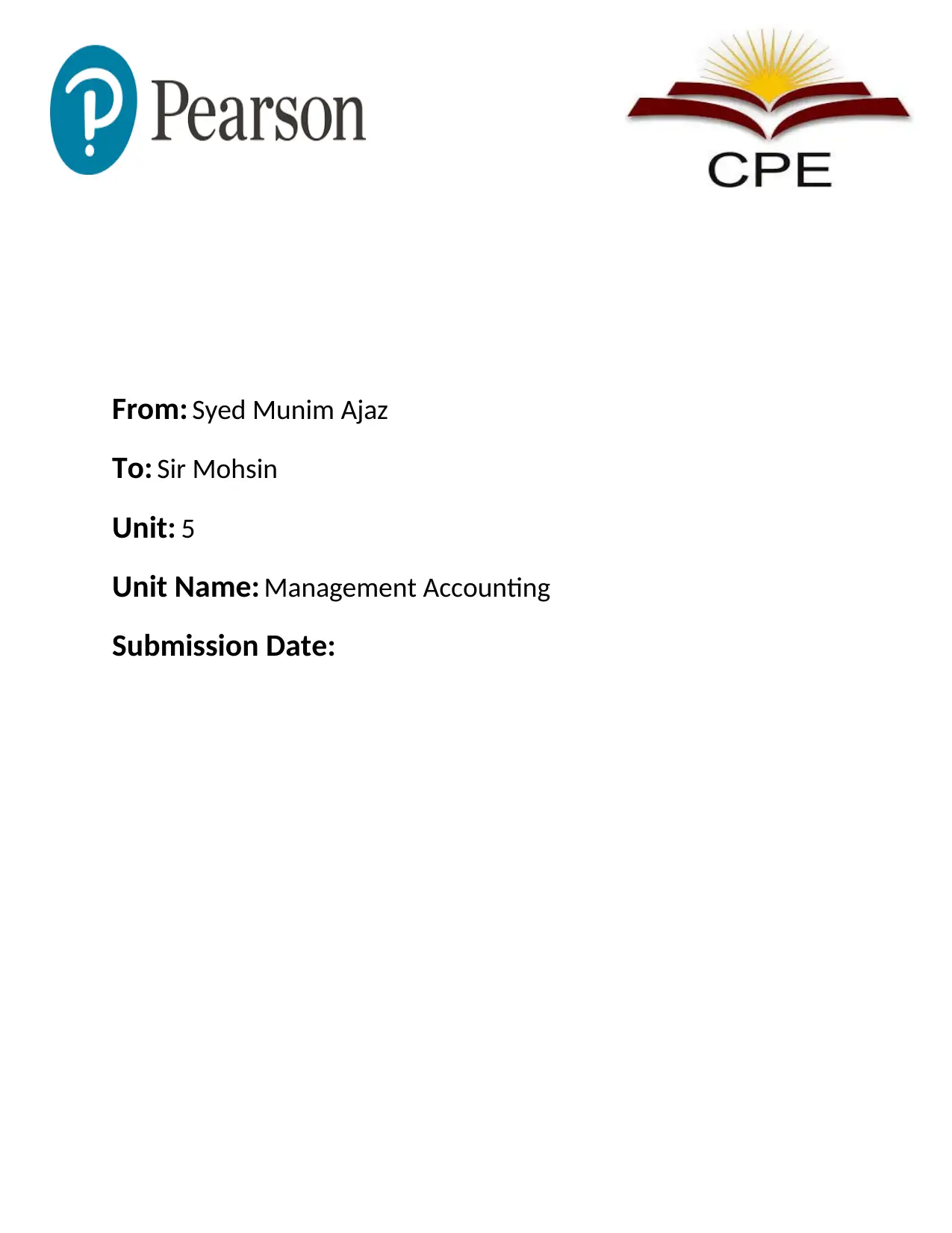
From: Syed Munim Ajaz
To: Sir Mohsin
Unit: 5
Unit Name: Management Accounting
Submission Date:
To: Sir Mohsin
Unit: 5
Unit Name: Management Accounting
Submission Date:
Paraphrase This Document
Need a fresh take? Get an instant paraphrase of this document with our AI Paraphraser
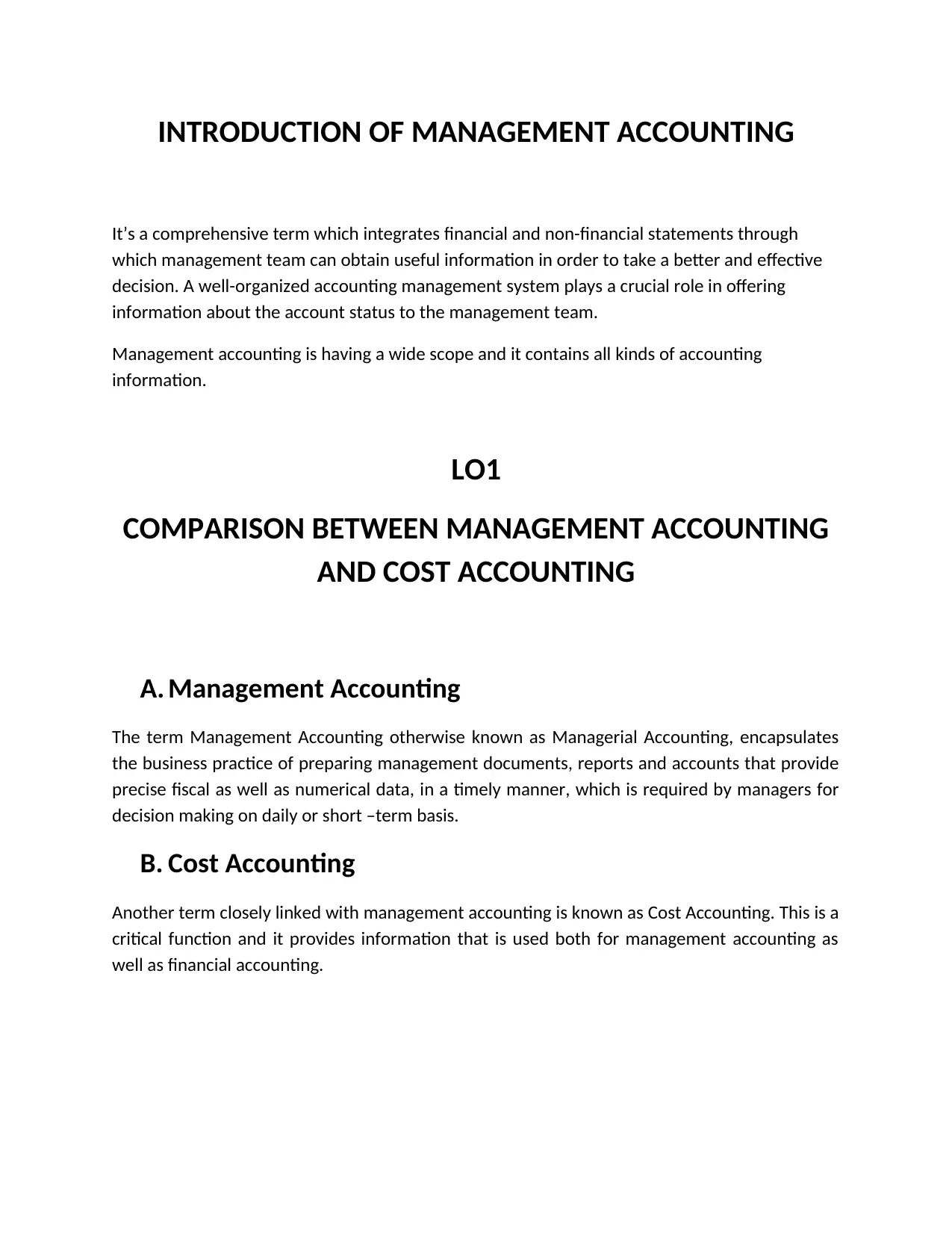
INTRODUCTION OF MANAGEMENT ACCOUNTING
It’s a comprehensive term which integrates financial and non-financial statements through
which management team can obtain useful information in order to take a better and effective
decision. A well-organized accounting management system plays a crucial role in offering
information about the account status to the management team.
Management accounting is having a wide scope and it contains all kinds of accounting
information.
LO1
COMPARISON BETWEEN MANAGEMENT ACCOUNTING
AND COST ACCOUNTING
A. Management Accounting
The term Management Accounting otherwise known as Managerial Accounting, encapsulates
the business practice of preparing management documents, reports and accounts that provide
precise fiscal as well as numerical data, in a timely manner, which is required by managers for
decision making on daily or short –term basis.
B. Cost Accounting
Another term closely linked with management accounting is known as Cost Accounting. This is a
critical function and it provides information that is used both for management accounting as
well as financial accounting.
It’s a comprehensive term which integrates financial and non-financial statements through
which management team can obtain useful information in order to take a better and effective
decision. A well-organized accounting management system plays a crucial role in offering
information about the account status to the management team.
Management accounting is having a wide scope and it contains all kinds of accounting
information.
LO1
COMPARISON BETWEEN MANAGEMENT ACCOUNTING
AND COST ACCOUNTING
A. Management Accounting
The term Management Accounting otherwise known as Managerial Accounting, encapsulates
the business practice of preparing management documents, reports and accounts that provide
precise fiscal as well as numerical data, in a timely manner, which is required by managers for
decision making on daily or short –term basis.
B. Cost Accounting
Another term closely linked with management accounting is known as Cost Accounting. This is a
critical function and it provides information that is used both for management accounting as
well as financial accounting.
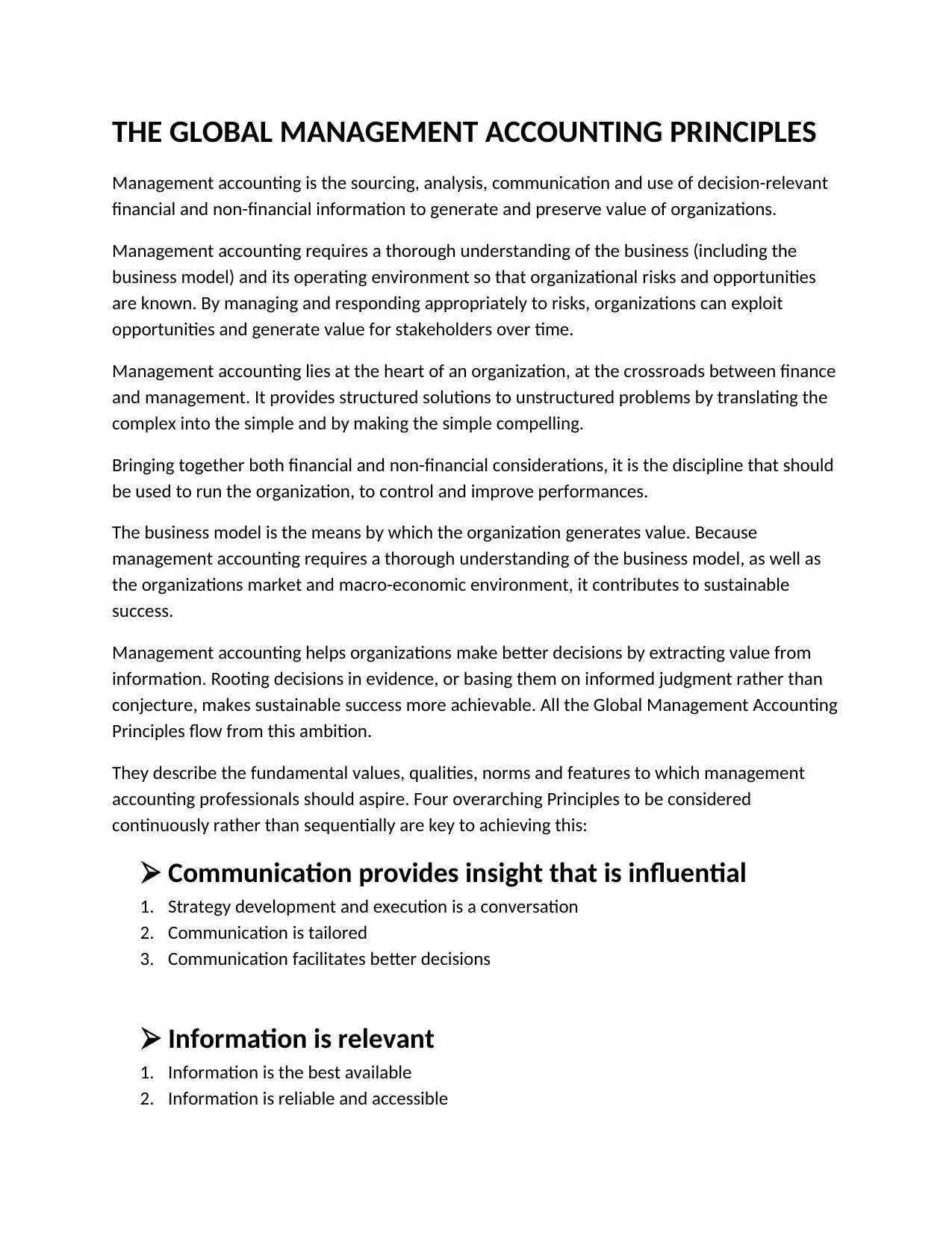
THE GLOBAL MANAGEMENT ACCOUNTING PRINCIPLES
Management accounting is the sourcing, analysis, communication and use of decision-relevant
financial and non-financial information to generate and preserve value of organizations.
Management accounting requires a thorough understanding of the business (including the
business model) and its operating environment so that organizational risks and opportunities
are known. By managing and responding appropriately to risks, organizations can exploit
opportunities and generate value for stakeholders over time.
Management accounting lies at the heart of an organization, at the crossroads between finance
and management. It provides structured solutions to unstructured problems by translating the
complex into the simple and by making the simple compelling.
Bringing together both financial and non-financial considerations, it is the discipline that should
be used to run the organization, to control and improve performances.
The business model is the means by which the organization generates value. Because
management accounting requires a thorough understanding of the business model, as well as
the organizations market and macro-economic environment, it contributes to sustainable
success.
Management accounting helps organizations make better decisions by extracting value from
information. Rooting decisions in evidence, or basing them on informed judgment rather than
conjecture, makes sustainable success more achievable. All the Global Management Accounting
Principles flow from this ambition.
They describe the fundamental values, qualities, norms and features to which management
accounting professionals should aspire. Four overarching Principles to be considered
continuously rather than sequentially are key to achieving this:
Communication provides insight that is influential
1. Strategy development and execution is a conversation
2. Communication is tailored
3. Communication facilitates better decisions
Information is relevant
1. Information is the best available
2. Information is reliable and accessible
Management accounting is the sourcing, analysis, communication and use of decision-relevant
financial and non-financial information to generate and preserve value of organizations.
Management accounting requires a thorough understanding of the business (including the
business model) and its operating environment so that organizational risks and opportunities
are known. By managing and responding appropriately to risks, organizations can exploit
opportunities and generate value for stakeholders over time.
Management accounting lies at the heart of an organization, at the crossroads between finance
and management. It provides structured solutions to unstructured problems by translating the
complex into the simple and by making the simple compelling.
Bringing together both financial and non-financial considerations, it is the discipline that should
be used to run the organization, to control and improve performances.
The business model is the means by which the organization generates value. Because
management accounting requires a thorough understanding of the business model, as well as
the organizations market and macro-economic environment, it contributes to sustainable
success.
Management accounting helps organizations make better decisions by extracting value from
information. Rooting decisions in evidence, or basing them on informed judgment rather than
conjecture, makes sustainable success more achievable. All the Global Management Accounting
Principles flow from this ambition.
They describe the fundamental values, qualities, norms and features to which management
accounting professionals should aspire. Four overarching Principles to be considered
continuously rather than sequentially are key to achieving this:
Communication provides insight that is influential
1. Strategy development and execution is a conversation
2. Communication is tailored
3. Communication facilitates better decisions
Information is relevant
1. Information is the best available
2. Information is reliable and accessible
⊘ This is a preview!⊘
Do you want full access?
Subscribe today to unlock all pages.

Trusted by 1+ million students worldwide
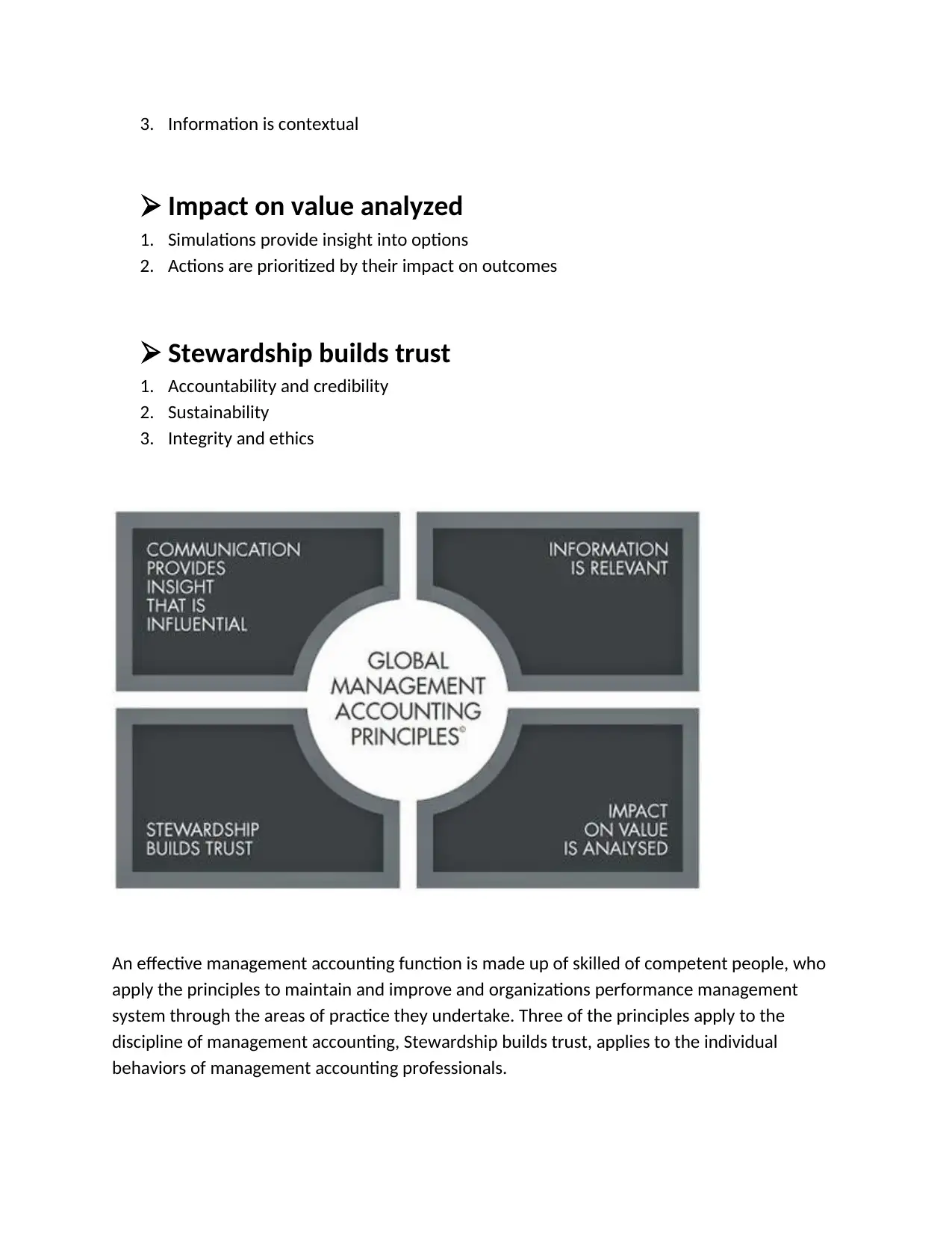
3. Information is contextual
Impact on value analyzed
1. Simulations provide insight into options
2. Actions are prioritized by their impact on outcomes
Stewardship builds trust
1. Accountability and credibility
2. Sustainability
3. Integrity and ethics
An effective management accounting function is made up of skilled of competent people, who
apply the principles to maintain and improve and organizations performance management
system through the areas of practice they undertake. Three of the principles apply to the
discipline of management accounting, Stewardship builds trust, applies to the individual
behaviors of management accounting professionals.
Impact on value analyzed
1. Simulations provide insight into options
2. Actions are prioritized by their impact on outcomes
Stewardship builds trust
1. Accountability and credibility
2. Sustainability
3. Integrity and ethics
An effective management accounting function is made up of skilled of competent people, who
apply the principles to maintain and improve and organizations performance management
system through the areas of practice they undertake. Three of the principles apply to the
discipline of management accounting, Stewardship builds trust, applies to the individual
behaviors of management accounting professionals.
Paraphrase This Document
Need a fresh take? Get an instant paraphrase of this document with our AI Paraphraser
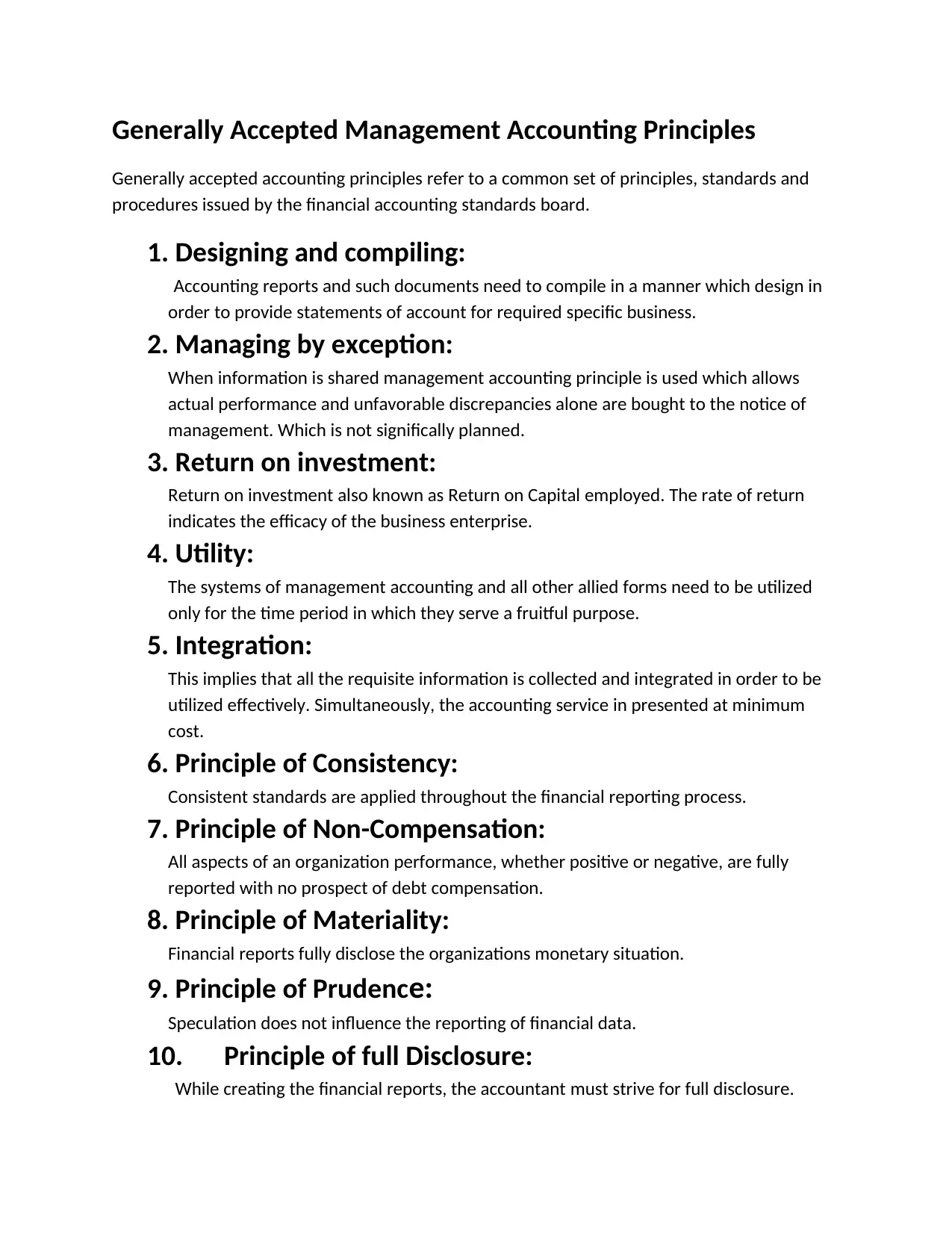
Generally Accepted Management Accounting Principles
Generally accepted accounting principles refer to a common set of principles, standards and
procedures issued by the financial accounting standards board.
1. Designing and compiling:
Accounting reports and such documents need to compile in a manner which design in
order to provide statements of account for required specific business.
2. Managing by exception:
When information is shared management accounting principle is used which allows
actual performance and unfavorable discrepancies alone are bought to the notice of
management. Which is not significally planned.
3. Return on investment:
Return on investment also known as Return on Capital employed. The rate of return
indicates the efficacy of the business enterprise.
4. Utility:
The systems of management accounting and all other allied forms need to be utilized
only for the time period in which they serve a fruitful purpose.
5. Integration:
This implies that all the requisite information is collected and integrated in order to be
utilized effectively. Simultaneously, the accounting service in presented at minimum
cost.
6. Principle of Consistency:
Consistent standards are applied throughout the financial reporting process.
7. Principle of Non-Compensation:
All aspects of an organization performance, whether positive or negative, are fully
reported with no prospect of debt compensation.
8. Principle of Materiality:
Financial reports fully disclose the organizations monetary situation.
9. Principle of Prudence:
Speculation does not influence the reporting of financial data.
10. Principle of full Disclosure:
While creating the financial reports, the accountant must strive for full disclosure.
Generally accepted accounting principles refer to a common set of principles, standards and
procedures issued by the financial accounting standards board.
1. Designing and compiling:
Accounting reports and such documents need to compile in a manner which design in
order to provide statements of account for required specific business.
2. Managing by exception:
When information is shared management accounting principle is used which allows
actual performance and unfavorable discrepancies alone are bought to the notice of
management. Which is not significally planned.
3. Return on investment:
Return on investment also known as Return on Capital employed. The rate of return
indicates the efficacy of the business enterprise.
4. Utility:
The systems of management accounting and all other allied forms need to be utilized
only for the time period in which they serve a fruitful purpose.
5. Integration:
This implies that all the requisite information is collected and integrated in order to be
utilized effectively. Simultaneously, the accounting service in presented at minimum
cost.
6. Principle of Consistency:
Consistent standards are applied throughout the financial reporting process.
7. Principle of Non-Compensation:
All aspects of an organization performance, whether positive or negative, are fully
reported with no prospect of debt compensation.
8. Principle of Materiality:
Financial reports fully disclose the organizations monetary situation.
9. Principle of Prudence:
Speculation does not influence the reporting of financial data.
10. Principle of full Disclosure:
While creating the financial reports, the accountant must strive for full disclosure.
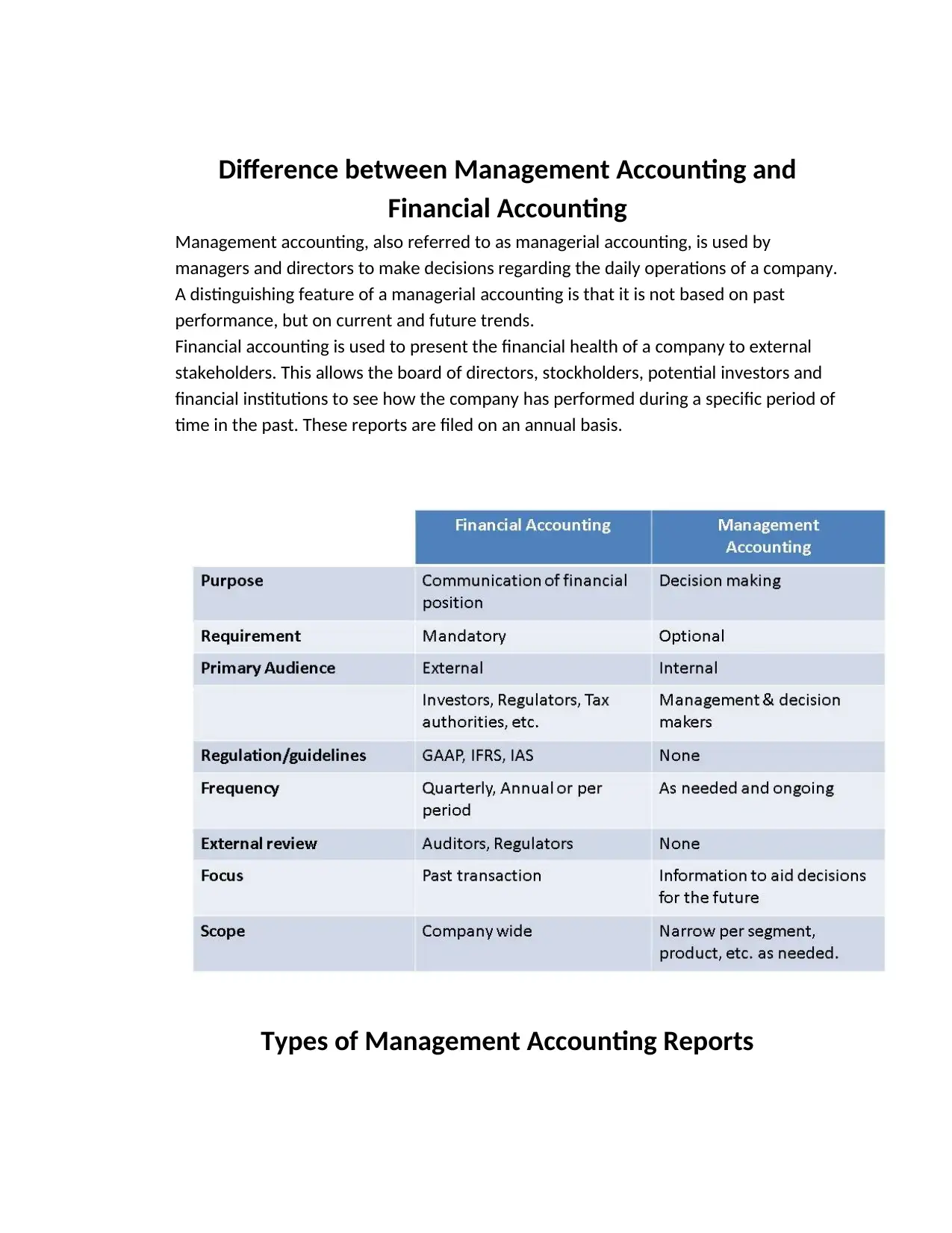
Difference between Management Accounting and
Financial Accounting
Management accounting, also referred to as managerial accounting, is used by
managers and directors to make decisions regarding the daily operations of a company.
A distinguishing feature of a managerial accounting is that it is not based on past
performance, but on current and future trends.
Financial accounting is used to present the financial health of a company to external
stakeholders. This allows the board of directors, stockholders, potential investors and
financial institutions to see how the company has performed during a specific period of
time in the past. These reports are filed on an annual basis.
Types of Management Accounting Reports
Financial Accounting
Management accounting, also referred to as managerial accounting, is used by
managers and directors to make decisions regarding the daily operations of a company.
A distinguishing feature of a managerial accounting is that it is not based on past
performance, but on current and future trends.
Financial accounting is used to present the financial health of a company to external
stakeholders. This allows the board of directors, stockholders, potential investors and
financial institutions to see how the company has performed during a specific period of
time in the past. These reports are filed on an annual basis.
Types of Management Accounting Reports
⊘ This is a preview!⊘
Do you want full access?
Subscribe today to unlock all pages.

Trusted by 1+ million students worldwide
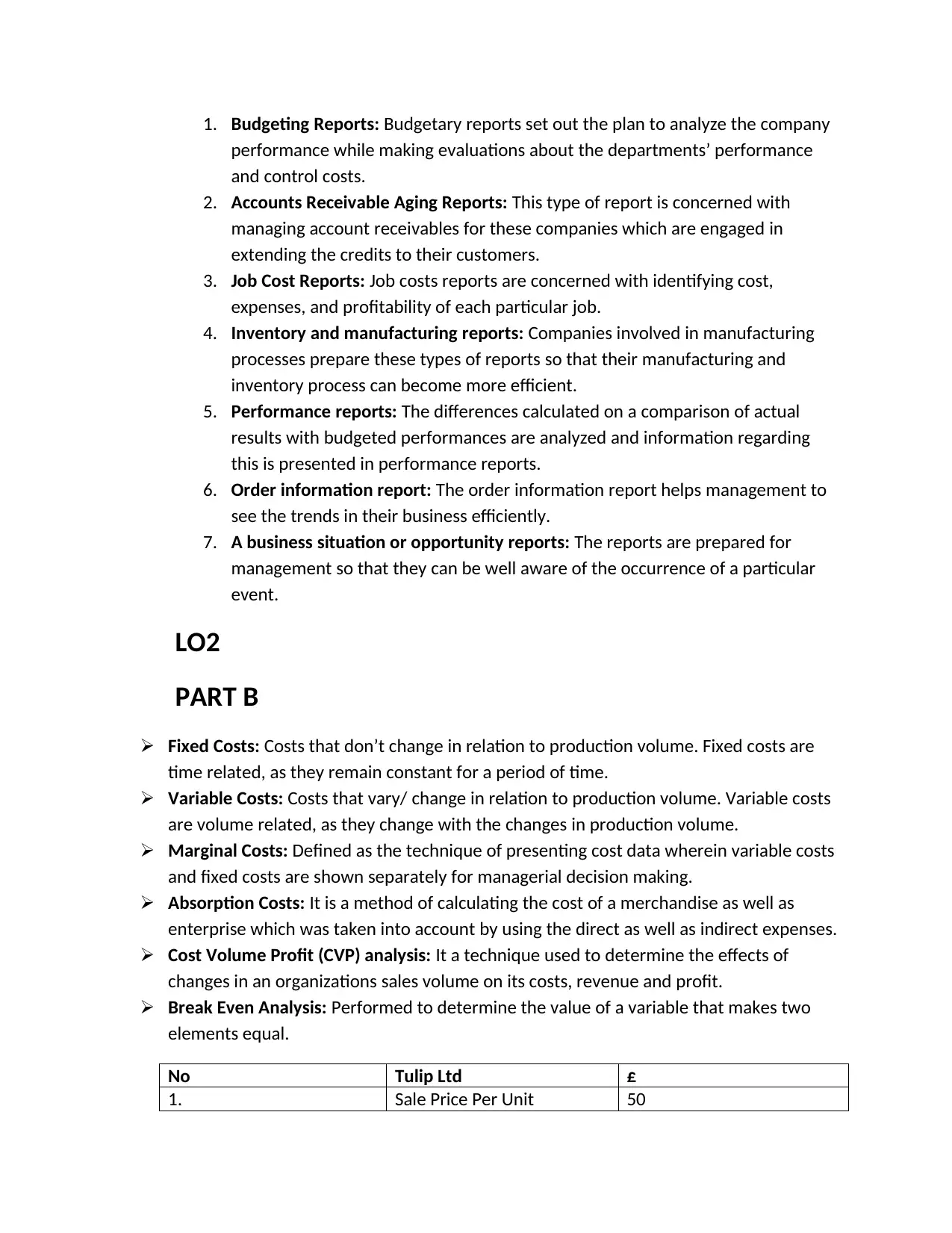
1. Budgeting Reports: Budgetary reports set out the plan to analyze the company
performance while making evaluations about the departments’ performance
and control costs.
2. Accounts Receivable Aging Reports: This type of report is concerned with
managing account receivables for these companies which are engaged in
extending the credits to their customers.
3. Job Cost Reports: Job costs reports are concerned with identifying cost,
expenses, and profitability of each particular job.
4. Inventory and manufacturing reports: Companies involved in manufacturing
processes prepare these types of reports so that their manufacturing and
inventory process can become more efficient.
5. Performance reports: The differences calculated on a comparison of actual
results with budgeted performances are analyzed and information regarding
this is presented in performance reports.
6. Order information report: The order information report helps management to
see the trends in their business efficiently.
7. A business situation or opportunity reports: The reports are prepared for
management so that they can be well aware of the occurrence of a particular
event.
LO2
PART B
Fixed Costs: Costs that don’t change in relation to production volume. Fixed costs are
time related, as they remain constant for a period of time.
Variable Costs: Costs that vary/ change in relation to production volume. Variable costs
are volume related, as they change with the changes in production volume.
Marginal Costs: Defined as the technique of presenting cost data wherein variable costs
and fixed costs are shown separately for managerial decision making.
Absorption Costs: It is a method of calculating the cost of a merchandise as well as
enterprise which was taken into account by using the direct as well as indirect expenses.
Cost Volume Profit (CVP) analysis: It a technique used to determine the effects of
changes in an organizations sales volume on its costs, revenue and profit.
Break Even Analysis: Performed to determine the value of a variable that makes two
elements equal.
No Tulip Ltd £
1. Sale Price Per Unit 50
performance while making evaluations about the departments’ performance
and control costs.
2. Accounts Receivable Aging Reports: This type of report is concerned with
managing account receivables for these companies which are engaged in
extending the credits to their customers.
3. Job Cost Reports: Job costs reports are concerned with identifying cost,
expenses, and profitability of each particular job.
4. Inventory and manufacturing reports: Companies involved in manufacturing
processes prepare these types of reports so that their manufacturing and
inventory process can become more efficient.
5. Performance reports: The differences calculated on a comparison of actual
results with budgeted performances are analyzed and information regarding
this is presented in performance reports.
6. Order information report: The order information report helps management to
see the trends in their business efficiently.
7. A business situation or opportunity reports: The reports are prepared for
management so that they can be well aware of the occurrence of a particular
event.
LO2
PART B
Fixed Costs: Costs that don’t change in relation to production volume. Fixed costs are
time related, as they remain constant for a period of time.
Variable Costs: Costs that vary/ change in relation to production volume. Variable costs
are volume related, as they change with the changes in production volume.
Marginal Costs: Defined as the technique of presenting cost data wherein variable costs
and fixed costs are shown separately for managerial decision making.
Absorption Costs: It is a method of calculating the cost of a merchandise as well as
enterprise which was taken into account by using the direct as well as indirect expenses.
Cost Volume Profit (CVP) analysis: It a technique used to determine the effects of
changes in an organizations sales volume on its costs, revenue and profit.
Break Even Analysis: Performed to determine the value of a variable that makes two
elements equal.
No Tulip Ltd £
1. Sale Price Per Unit 50
Paraphrase This Document
Need a fresh take? Get an instant paraphrase of this document with our AI Paraphraser
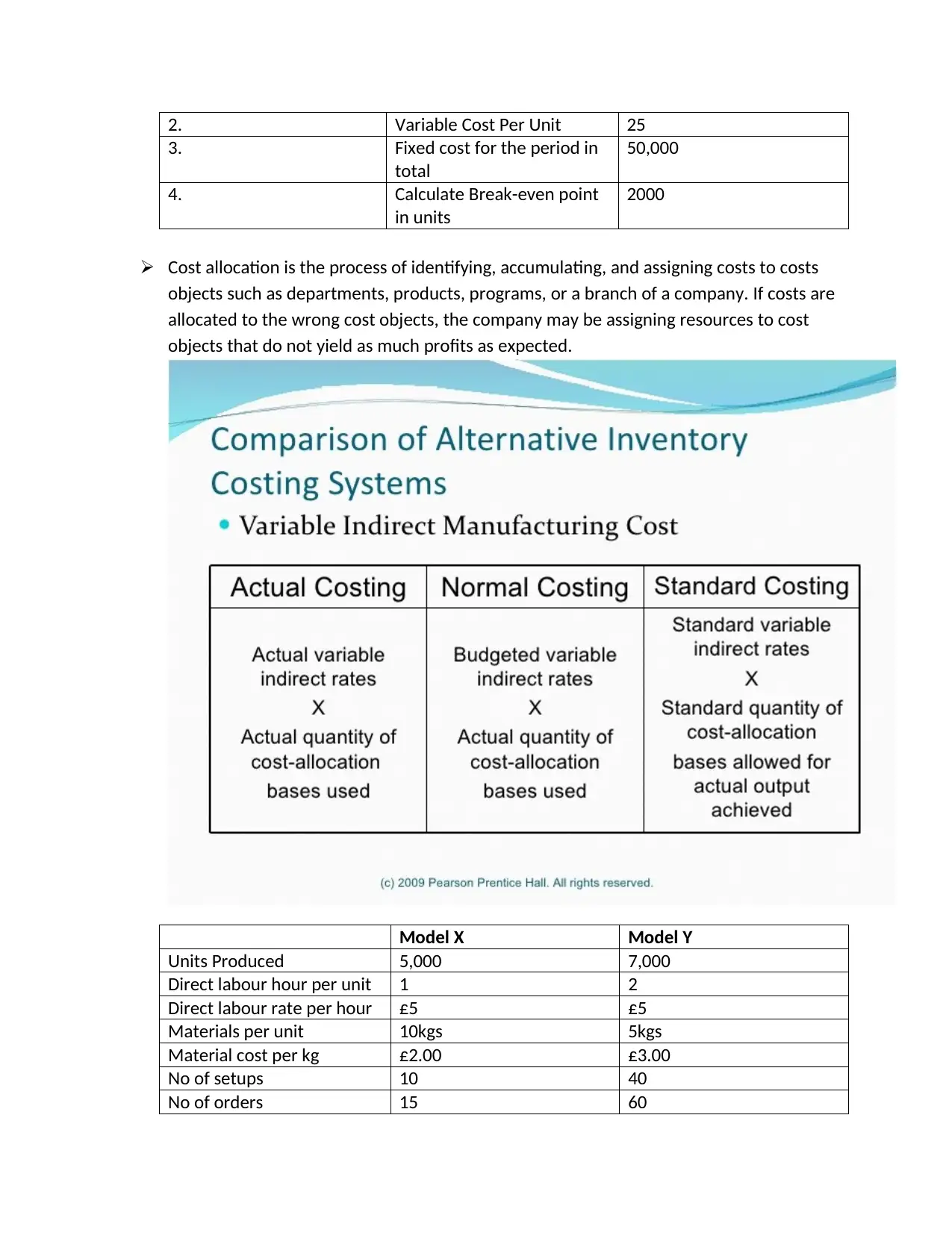
2. Variable Cost Per Unit 25
3. Fixed cost for the period in
total
50,000
4. Calculate Break-even point
in units
2000
Cost allocation is the process of identifying, accumulating, and assigning costs to costs
objects such as departments, products, programs, or a branch of a company. If costs are
allocated to the wrong cost objects, the company may be assigning resources to cost
objects that do not yield as much profits as expected.
Model X Model Y
Units Produced 5,000 7,000
Direct labour hour per unit 1 2
Direct labour rate per hour £5 £5
Materials per unit 10kgs 5kgs
Material cost per kg £2.00 £3.00
No of setups 10 40
No of orders 15 60
3. Fixed cost for the period in
total
50,000
4. Calculate Break-even point
in units
2000
Cost allocation is the process of identifying, accumulating, and assigning costs to costs
objects such as departments, products, programs, or a branch of a company. If costs are
allocated to the wrong cost objects, the company may be assigning resources to cost
objects that do not yield as much profits as expected.
Model X Model Y
Units Produced 5,000 7,000
Direct labour hour per unit 1 2
Direct labour rate per hour £5 £5
Materials per unit 10kgs 5kgs
Material cost per kg £2.00 £3.00
No of setups 10 40
No of orders 15 60
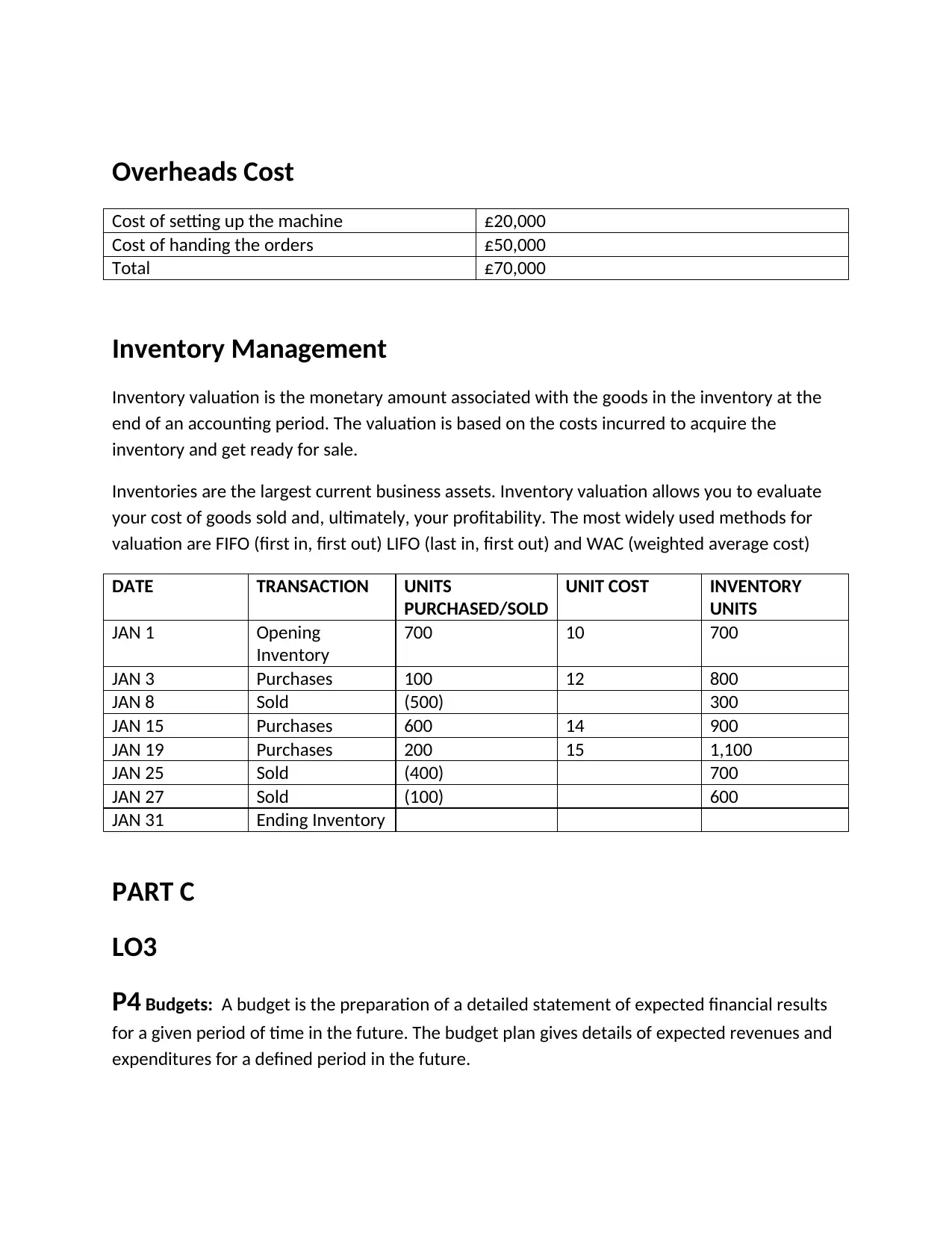
Overheads Cost
Cost of setting up the machine £20,000
Cost of handing the orders £50,000
Total £70,000
Inventory Management
Inventory valuation is the monetary amount associated with the goods in the inventory at the
end of an accounting period. The valuation is based on the costs incurred to acquire the
inventory and get ready for sale.
Inventories are the largest current business assets. Inventory valuation allows you to evaluate
your cost of goods sold and, ultimately, your profitability. The most widely used methods for
valuation are FIFO (first in, first out) LIFO (last in, first out) and WAC (weighted average cost)
DATE TRANSACTION UNITS
PURCHASED/SOLD
UNIT COST INVENTORY
UNITS
JAN 1 Opening
Inventory
700 10 700
JAN 3 Purchases 100 12 800
JAN 8 Sold (500) 300
JAN 15 Purchases 600 14 900
JAN 19 Purchases 200 15 1,100
JAN 25 Sold (400) 700
JAN 27 Sold (100) 600
JAN 31 Ending Inventory
PART C
LO3
P4 Budgets: A budget is the preparation of a detailed statement of expected financial results
for a given period of time in the future. The budget plan gives details of expected revenues and
expenditures for a defined period in the future.
Cost of setting up the machine £20,000
Cost of handing the orders £50,000
Total £70,000
Inventory Management
Inventory valuation is the monetary amount associated with the goods in the inventory at the
end of an accounting period. The valuation is based on the costs incurred to acquire the
inventory and get ready for sale.
Inventories are the largest current business assets. Inventory valuation allows you to evaluate
your cost of goods sold and, ultimately, your profitability. The most widely used methods for
valuation are FIFO (first in, first out) LIFO (last in, first out) and WAC (weighted average cost)
DATE TRANSACTION UNITS
PURCHASED/SOLD
UNIT COST INVENTORY
UNITS
JAN 1 Opening
Inventory
700 10 700
JAN 3 Purchases 100 12 800
JAN 8 Sold (500) 300
JAN 15 Purchases 600 14 900
JAN 19 Purchases 200 15 1,100
JAN 25 Sold (400) 700
JAN 27 Sold (100) 600
JAN 31 Ending Inventory
PART C
LO3
P4 Budgets: A budget is the preparation of a detailed statement of expected financial results
for a given period of time in the future. The budget plan gives details of expected revenues and
expenditures for a defined period in the future.
⊘ This is a preview!⊘
Do you want full access?
Subscribe today to unlock all pages.

Trusted by 1+ million students worldwide
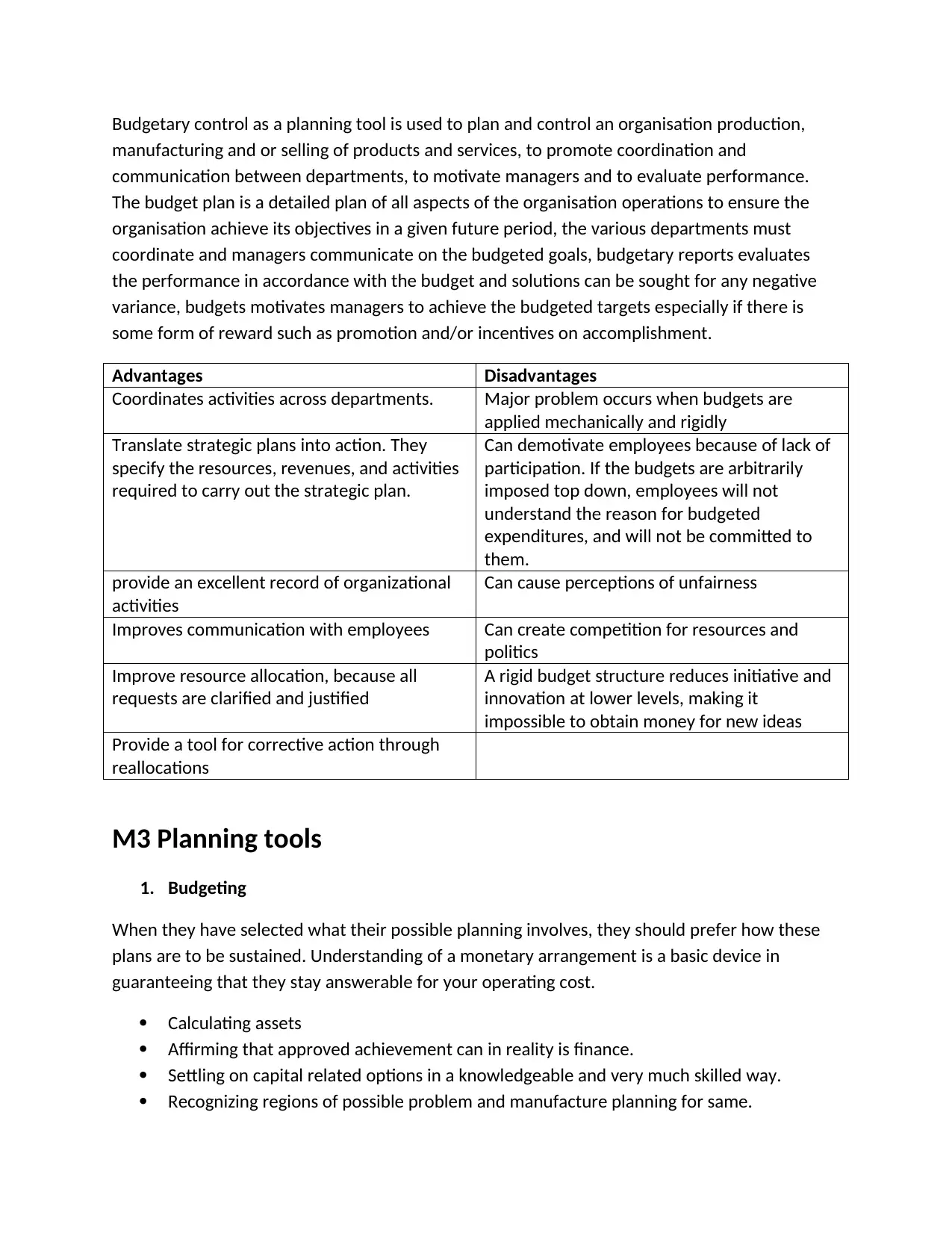
Budgetary control as a planning tool is used to plan and control an organisation production,
manufacturing and or selling of products and services, to promote coordination and
communication between departments, to motivate managers and to evaluate performance.
The budget plan is a detailed plan of all aspects of the organisation operations to ensure the
organisation achieve its objectives in a given future period, the various departments must
coordinate and managers communicate on the budgeted goals, budgetary reports evaluates
the performance in accordance with the budget and solutions can be sought for any negative
variance, budgets motivates managers to achieve the budgeted targets especially if there is
some form of reward such as promotion and/or incentives on accomplishment.
Advantages Disadvantages
Coordinates activities across departments. Major problem occurs when budgets are
applied mechanically and rigidly
Translate strategic plans into action. They
specify the resources, revenues, and activities
required to carry out the strategic plan.
Can demotivate employees because of lack of
participation. If the budgets are arbitrarily
imposed top down, employees will not
understand the reason for budgeted
expenditures, and will not be committed to
them.
provide an excellent record of organizational
activities
Can cause perceptions of unfairness
Improves communication with employees Can create competition for resources and
politics
Improve resource allocation, because all
requests are clarified and justified
A rigid budget structure reduces initiative and
innovation at lower levels, making it
impossible to obtain money for new ideas
Provide a tool for corrective action through
reallocations
M3 Planning tools
1. Budgeting
When they have selected what their possible planning involves, they should prefer how these
plans are to be sustained. Understanding of a monetary arrangement is a basic device in
guaranteeing that they stay answerable for your operating cost.
Calculating assets
Affirming that approved achievement can in reality is finance.
Settling on capital related options in a knowledgeable and very much skilled way.
Recognizing regions of possible problem and manufacture planning for same.
manufacturing and or selling of products and services, to promote coordination and
communication between departments, to motivate managers and to evaluate performance.
The budget plan is a detailed plan of all aspects of the organisation operations to ensure the
organisation achieve its objectives in a given future period, the various departments must
coordinate and managers communicate on the budgeted goals, budgetary reports evaluates
the performance in accordance with the budget and solutions can be sought for any negative
variance, budgets motivates managers to achieve the budgeted targets especially if there is
some form of reward such as promotion and/or incentives on accomplishment.
Advantages Disadvantages
Coordinates activities across departments. Major problem occurs when budgets are
applied mechanically and rigidly
Translate strategic plans into action. They
specify the resources, revenues, and activities
required to carry out the strategic plan.
Can demotivate employees because of lack of
participation. If the budgets are arbitrarily
imposed top down, employees will not
understand the reason for budgeted
expenditures, and will not be committed to
them.
provide an excellent record of organizational
activities
Can cause perceptions of unfairness
Improves communication with employees Can create competition for resources and
politics
Improve resource allocation, because all
requests are clarified and justified
A rigid budget structure reduces initiative and
innovation at lower levels, making it
impossible to obtain money for new ideas
Provide a tool for corrective action through
reallocations
M3 Planning tools
1. Budgeting
When they have selected what their possible planning involves, they should prefer how these
plans are to be sustained. Understanding of a monetary arrangement is a basic device in
guaranteeing that they stay answerable for your operating cost.
Calculating assets
Affirming that approved achievement can in reality is finance.
Settling on capital related options in a knowledgeable and very much skilled way.
Recognizing regions of possible problem and manufacture planning for same.
Paraphrase This Document
Need a fresh take? Get an instant paraphrase of this document with our AI Paraphraser
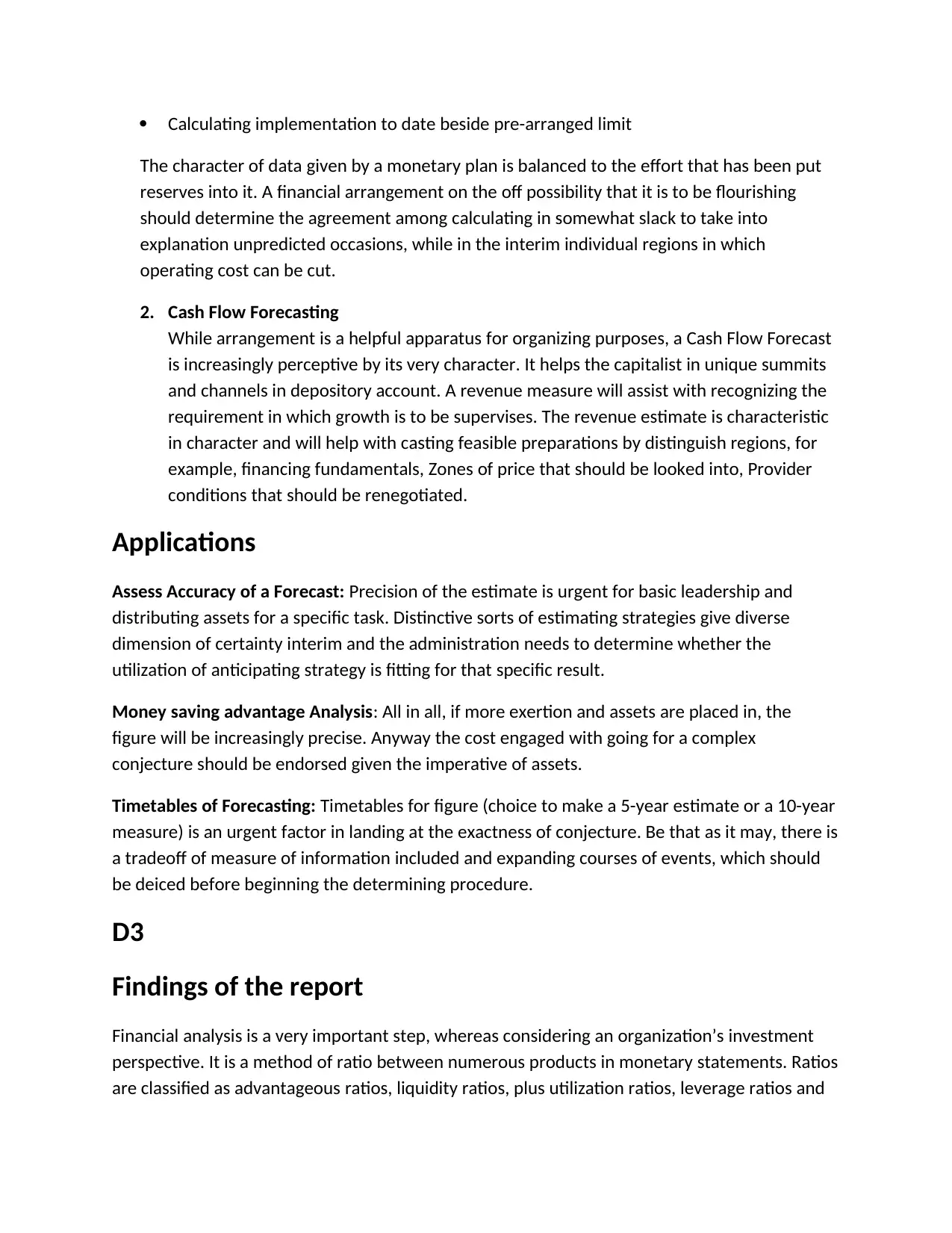
Calculating implementation to date beside pre-arranged limit
The character of data given by a monetary plan is balanced to the effort that has been put
reserves into it. A financial arrangement on the off possibility that it is to be flourishing
should determine the agreement among calculating in somewhat slack to take into
explanation unpredicted occasions, while in the interim individual regions in which
operating cost can be cut.
2. Cash Flow Forecasting
While arrangement is a helpful apparatus for organizing purposes, a Cash Flow Forecast
is increasingly perceptive by its very character. It helps the capitalist in unique summits
and channels in depository account. A revenue measure will assist with recognizing the
requirement in which growth is to be supervises. The revenue estimate is characteristic
in character and will help with casting feasible preparations by distinguish regions, for
example, financing fundamentals, Zones of price that should be looked into, Provider
conditions that should be renegotiated.
Applications
Assess Accuracy of a Forecast: Precision of the estimate is urgent for basic leadership and
distributing assets for a specific task. Distinctive sorts of estimating strategies give diverse
dimension of certainty interim and the administration needs to determine whether the
utilization of anticipating strategy is fitting for that specific result.
Money saving advantage Analysis: All in all, if more exertion and assets are placed in, the
figure will be increasingly precise. Anyway the cost engaged with going for a complex
conjecture should be endorsed given the imperative of assets.
Timetables of Forecasting: Timetables for figure (choice to make a 5-year estimate or a 10-year
measure) is an urgent factor in landing at the exactness of conjecture. Be that as it may, there is
a tradeoff of measure of information included and expanding courses of events, which should
be deiced before beginning the determining procedure.
D3
Findings of the report
Financial analysis is a very important step, whereas considering an organization’s investment
perspective. It is a method of ratio between numerous products in monetary statements. Ratios
are classified as advantageous ratios, liquidity ratios, plus utilization ratios, leverage ratios and
The character of data given by a monetary plan is balanced to the effort that has been put
reserves into it. A financial arrangement on the off possibility that it is to be flourishing
should determine the agreement among calculating in somewhat slack to take into
explanation unpredicted occasions, while in the interim individual regions in which
operating cost can be cut.
2. Cash Flow Forecasting
While arrangement is a helpful apparatus for organizing purposes, a Cash Flow Forecast
is increasingly perceptive by its very character. It helps the capitalist in unique summits
and channels in depository account. A revenue measure will assist with recognizing the
requirement in which growth is to be supervises. The revenue estimate is characteristic
in character and will help with casting feasible preparations by distinguish regions, for
example, financing fundamentals, Zones of price that should be looked into, Provider
conditions that should be renegotiated.
Applications
Assess Accuracy of a Forecast: Precision of the estimate is urgent for basic leadership and
distributing assets for a specific task. Distinctive sorts of estimating strategies give diverse
dimension of certainty interim and the administration needs to determine whether the
utilization of anticipating strategy is fitting for that specific result.
Money saving advantage Analysis: All in all, if more exertion and assets are placed in, the
figure will be increasingly precise. Anyway the cost engaged with going for a complex
conjecture should be endorsed given the imperative of assets.
Timetables of Forecasting: Timetables for figure (choice to make a 5-year estimate or a 10-year
measure) is an urgent factor in landing at the exactness of conjecture. Be that as it may, there is
a tradeoff of measure of information included and expanding courses of events, which should
be deiced before beginning the determining procedure.
D3
Findings of the report
Financial analysis is a very important step, whereas considering an organization’s investment
perspective. It is a method of ratio between numerous products in monetary statements. Ratios
are classified as advantageous ratios, liquidity ratios, plus utilization ratios, leverage ratios and
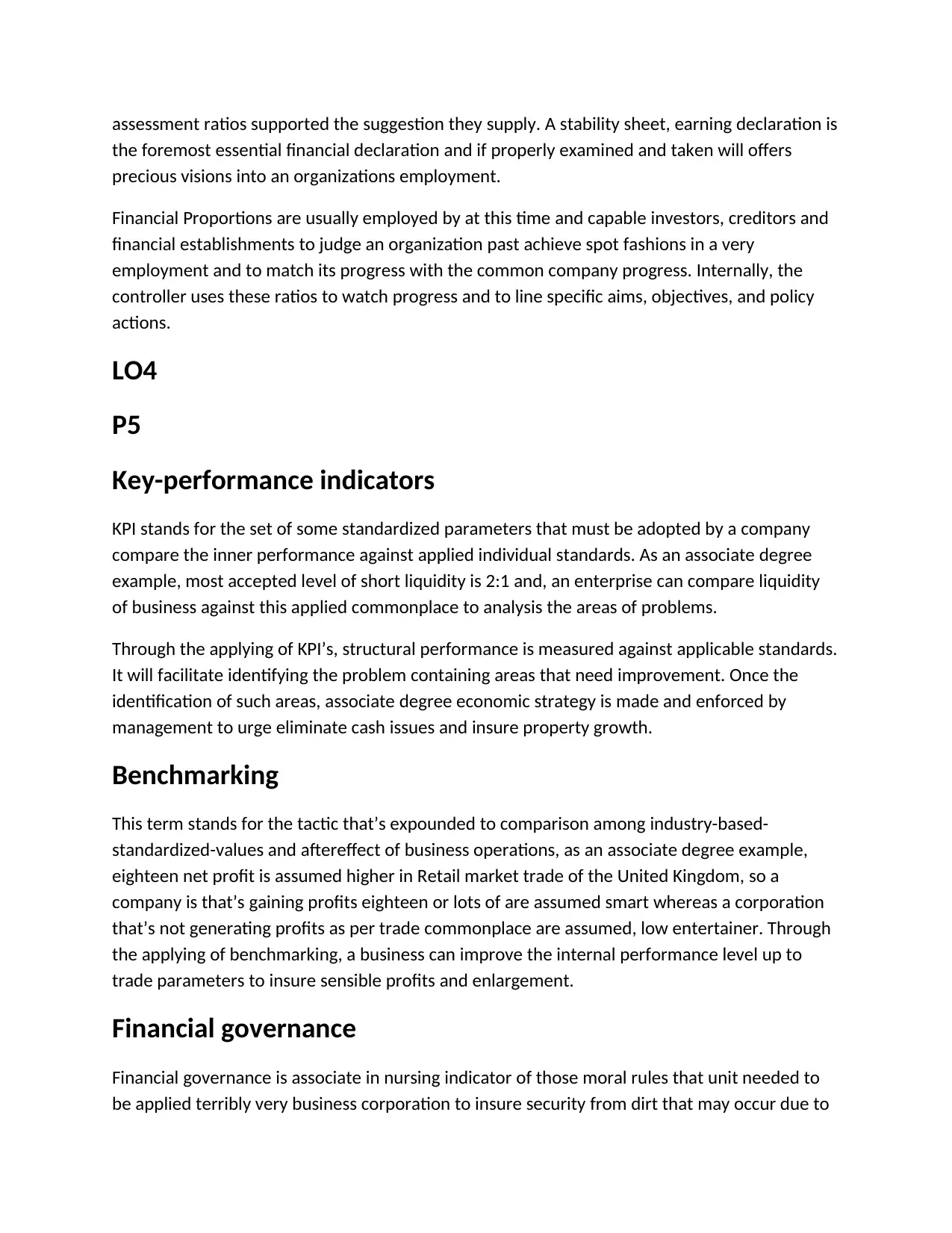
assessment ratios supported the suggestion they supply. A stability sheet, earning declaration is
the foremost essential financial declaration and if properly examined and taken will offers
precious visions into an organizations employment.
Financial Proportions are usually employed by at this time and capable investors, creditors and
financial establishments to judge an organization past achieve spot fashions in a very
employment and to match its progress with the common company progress. Internally, the
controller uses these ratios to watch progress and to line specific aims, objectives, and policy
actions.
LO4
P5
Key-performance indicators
KPI stands for the set of some standardized parameters that must be adopted by a company
compare the inner performance against applied individual standards. As an associate degree
example, most accepted level of short liquidity is 2:1 and, an enterprise can compare liquidity
of business against this applied commonplace to analysis the areas of problems.
Through the applying of KPI’s, structural performance is measured against applicable standards.
It will facilitate identifying the problem containing areas that need improvement. Once the
identification of such areas, associate degree economic strategy is made and enforced by
management to urge eliminate cash issues and insure property growth.
Benchmarking
This term stands for the tactic that’s expounded to comparison among industry-based-
standardized-values and aftereffect of business operations, as an associate degree example,
eighteen net profit is assumed higher in Retail market trade of the United Kingdom, so a
company is that’s gaining profits eighteen or lots of are assumed smart whereas a corporation
that’s not generating profits as per trade commonplace are assumed, low entertainer. Through
the applying of benchmarking, a business can improve the internal performance level up to
trade parameters to insure sensible profits and enlargement.
Financial governance
Financial governance is associate in nursing indicator of those moral rules that unit needed to
be applied terribly very business corporation to insure security from dirt that may occur due to
the foremost essential financial declaration and if properly examined and taken will offers
precious visions into an organizations employment.
Financial Proportions are usually employed by at this time and capable investors, creditors and
financial establishments to judge an organization past achieve spot fashions in a very
employment and to match its progress with the common company progress. Internally, the
controller uses these ratios to watch progress and to line specific aims, objectives, and policy
actions.
LO4
P5
Key-performance indicators
KPI stands for the set of some standardized parameters that must be adopted by a company
compare the inner performance against applied individual standards. As an associate degree
example, most accepted level of short liquidity is 2:1 and, an enterprise can compare liquidity
of business against this applied commonplace to analysis the areas of problems.
Through the applying of KPI’s, structural performance is measured against applicable standards.
It will facilitate identifying the problem containing areas that need improvement. Once the
identification of such areas, associate degree economic strategy is made and enforced by
management to urge eliminate cash issues and insure property growth.
Benchmarking
This term stands for the tactic that’s expounded to comparison among industry-based-
standardized-values and aftereffect of business operations, as an associate degree example,
eighteen net profit is assumed higher in Retail market trade of the United Kingdom, so a
company is that’s gaining profits eighteen or lots of are assumed smart whereas a corporation
that’s not generating profits as per trade commonplace are assumed, low entertainer. Through
the applying of benchmarking, a business can improve the internal performance level up to
trade parameters to insure sensible profits and enlargement.
Financial governance
Financial governance is associate in nursing indicator of those moral rules that unit needed to
be applied terribly very business corporation to insure security from dirt that may occur due to
⊘ This is a preview!⊘
Do you want full access?
Subscribe today to unlock all pages.

Trusted by 1+ million students worldwide
1 out of 14
Related Documents
Your All-in-One AI-Powered Toolkit for Academic Success.
+13062052269
info@desklib.com
Available 24*7 on WhatsApp / Email
![[object Object]](/_next/static/media/star-bottom.7253800d.svg)
Unlock your academic potential
Copyright © 2020–2025 A2Z Services. All Rights Reserved. Developed and managed by ZUCOL.




